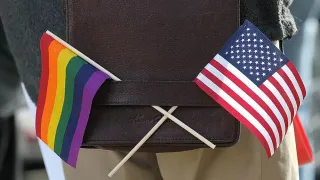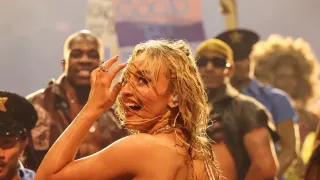
3 hours ago
Parking Spots Used as Colorful Protest Against Florida Crackdown on Rainbow Crosswalks
READ TIME: 2 MIN.
An Orlando restaurateur on Monday turned over 49 parking spots outside her eatery for artists to color as a protest against a state mandate removing rainbow-colored crosswalks and other art on Florida streets, including one outside the LGBTQ-friendly nightclub where 49 people were killed in 2016.
Se7en Bites owner Trina Gregory said she received 1,000 applications for the event dubbed “Parking Space for Pride — A Rainbow Connection,” after she put out word that the parking spaces would be open for coloring as a salute to diversity and artistic expression. The parking spots are on private property and not under government control.
The idea came in response to the administration of Republican Gov. Ron DeSantis’ enforcement of a state code which prohibits “surface art” on crosswalks, sidewalks, intersections, travel lanes or shoulders. A memo issued by the Florida Department of Transportation this summer prohibited “surface art” associated with “social, political or ideological messages or images and does not serve the purpose of traffic control.” It warned that transportation funds could be held withheld if municipalities failed to comply.
Many of the painted crosswalks celebrate historically marginalized groups such as the LGBTQ+ and Black communities. Last month in the middle of the night , state transportation workers painted over the rainbow-colored crosswalk outside the LGBTQ-friendly Pulse nightclub in Orlando where 49 patrons were massacred in what was the worst mass shooting in the U.S. at the time. Since then, protesters have repeatedly colored-in the crosswalk with chalk.
“Art has always been a form of resistance and healing,” Gregory said. ”If they want to erase symbols of pride and acceptance, then we’ll create even more of them. This isn’t just about paint, it’s about community, visibility, and love.”
Critics say the crosswalk restriction is the latest attack on the LGBTQ+ community by the DeSantis administration and Republican-controlled Legislature, including restrictions on gender-affirming care and Florida’s measure commonly referred to as Don’t Say Gay, which banned classroom discussion about sexual orientation and gender identity in certain grades. Other communities also are using art to protest the new prohibition on street art. Members of the Harvest Sarasota Church in Sarasota on Sunday painted 500 feet (152 meters) of rainbow colors between two buildings.
Pastor Dan Minor told reporters that church members felt compelled to act once the crosswalk crackdown took off last month.






